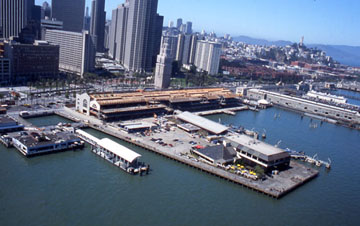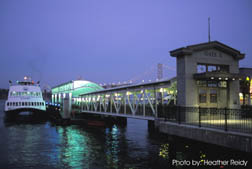
Ferries to the Rescue: When
bridges and tunnels are disabled by emergencies, ferries become
lifeboats
 |
| The
San Francisco Ferry Building, the regional hub for ferry
landings, connects with more landside transit lines than any
other location in the Bay (Bob Ecker, photographer) |
The WTA Takes the Lead in Regional
Maritime Response Planning
If the California Legislature
approves the San Francisco Bay Area Water Transit Authority (WTA)’s
recommendations and this plan is funded, 31 new boats will be added
to the current fleet of ferries for a total of 44
ferry boats in the Bay and as many as eight new terminal locations.
These additional boats and terminals will expand emergency access to
nearly all Bay Area cities when other transportation systems are
down. The WTA will coordinate updating the portion of the
Metropolitan Transportation Commission’s Trans Response Plan, the
emergency response plan that lays out the role for ferries and other
small craft such as tugboats and fishing boats in the event of a
disaster. This portion was last updated in 1996.
 |
| The
new Muni F-line connects the San Francisco ferry building to
Fisherman’s wharf to the North and runs down the City’s
main thorougfare, Market Street |
Coordination of the Bay Area’s
maritime response plan has already begun: the WTA has hosted two
organizing meetings to seek early input from ferry operators, Coast
Guard, Office of Emergency Services, and others. In the plan that it
delivered to the California Legislature in December 2002, the WTA
has recommended that new ferries be more emergency-ready, equipped
with such features as both side and front-loading for flexible
boarding.
WTA board member Joe Freitas said,
"Every new ferry boat that we put on the Bay is an emergency
response asset for Bay Area residents. This was proven in New York
with 911. I’ve strongly urged our agency to search for funds from
new Federal Homeland Security grants and this
advocacy will continue as part of the WTA’s long-term plan."

OPERATION RETURN
Using ferries to
bring safety and emergency workers back to SF and other
points. SF Office of Emergency Services Director Lu
Canton’s vision for using ferries for essential emergency
services includes not only the potential for transporting or
evacuating residents, but "Operation Returns"
would enlist ferries to shuttle City workers between
necessary points. Mr. Canton said that MTC had begun
investigating pick-up and drop-off locations, but that this
plan requires much more time investment in order to be
workable. |
Bay Area Offices of Emergency
Services Welcome WTA’s Plan
Lucien Canton, Director of San
Francisco’s Office of Emergency Services (OES), has a plan to
handle fires, floods, earthquakes, hazardous materials, terrorism,
meteor strikes and even alien invasion. Housed in an understated
facility on Turk Street, the OES is a cross between the Bat Cave and
a military operation.
One visit to the OES is enough to
prove its worth in the City’s budget, even during times of fiscal
uncertainty. Starting with the communications equipment, the OES
relies upon layers of backup contingencies. If the emergency phone
system, wired with copper wires to all critical City offices fails,
faxes, computers with Internet access and radio systems are all
available. Should everything else fail, Mr.
Canton has a plan to deploy bike messengers. Although not presently
housed at the OES, courier pigeons can’t be far behind.
Although inter-departmental
coordination is sometimes a challenge, Mr. Canton acknowledged the
need for regional coordination, as well. Any disaster disabling the
roads, bridges, and tunnels would affect access between San Francisco
and other Bay Area cities.
San Mateo and Contra Costa
Both the Contra Costa County and
San Mateo County Offices of Emergency Services are supporting the
WTA in seeking funding for ferries. In Contra Costa County, the WTA
recommended that new terminals be sited in Richmond, Hercules,
Martinez, and Antioch. If the Bay Bridge or BART system went down,
ferry service to these areas would be essential. San Mateo County
would have new terminals in South San Francisco and further south in
Redwood City.
Lt. Steve Shively, San Mateo
County’s Office of Emergency Services Area Coordinator said,
"I’m excited about the plan to build two new ferry terminals
in San Mateo County. You can never predict when emergencies will
happen. We need to be prepared at all times and ferries will help us
to be ready." With a new emphasis on bridge threats, his
office has added terrorism to the list of potential disasters it
covers.
Lt. Shively explained that moving
emergency personnel, especially first responders, has become a
challenge to his office since emergency personnel often can’t
afford to live in the City in which they serve. "Having new
ferries available to transport them across the Bay should the San
Mateo and Dumbarton bridges be impassable will enormously boost our
ability to quickly mobilize and deliver first-responder
personnel," he said.
Marin
Marin County’s Director of
Emergency Services, Supervisor Cynthia Murray, who sits on the WTA’s
Community Advisory Committee, said, "On the morning of 911, the
CHP informed the County of Marin, if necessary, they would evacuate
San Francisco into Marin County. That would have required making the
Golden Gate Bridge one way out of San Francisco and mobilizing all
of the ferries to shuttle people out of the city. Ferries play a
unique role in providing additional capacity if needed in an
emergency."
 |
| The
San Francisco Port hopes to add 4 more floating docks to
accomodate new Bay Area ferry routes and for quicker
evacuation and delivery of emergency personnel |
San Francisco Port: the Regional
Hub for Disaster Response
The endpoint for all ferry routes
is the San Francisco Port, which has undergone major revitalization
over the past couple of decades and which connects to a greater
number of landside transit lines than any other location in the Bay.
If the WTA’s plan is fully implemented, the Port would have a need
to expand its capacity just to accommodate daily ferry traffic,
never mind accommodating an evacuation.
Nieret Mizushima, Chief Harbor
Engineer for the Port of San Francisco, commented on the Port’s
emergency preparedness measures put in place after the1989 Loma
Prieta Earthquake. She said, "The two new ferry terminals and
access from the roadway were designed and constructed to remain
fully operational in the event of a major earthquake. Each dock is
equipped with generators for emergency lighting and equipment
operation. And, we’ve widened ramps to
substantially increase capacity for loading and unloading of
passengers. Looking to the future, we hope to fund additional floats
for simultaneous docking to allow not just for daily commuters but
for a quick evacuation or for bringing in emergency personnel. Our
goal is to also make the ferries further
accessible to those with disabilities, medical gurneys, a wider
variety of transit operators and emergency vehicles."
Twenty Million Dollars Worth of
Funding for the SF Port in SB 916
If passed by the Legislature and approved by Bay
Area voters, SB 916 would increase tolls on all State-owned bridges
by $1 starting July 1, 2004. The Port of San Francisco is expected
to receive $20 million to fund S.F. Port infrastructure improvements
out of the proposed bridge toll increase. The Port of San Francisco
has also submitted a request for funding from the reauthorization of
San Francisco’s half-cent transportation sales tax measure likely
to be voted on in November 2003. This is a twenty-year spending plan
for the city’s transportation projects.